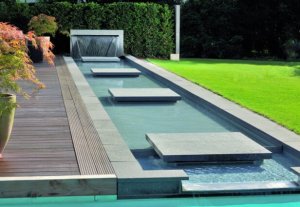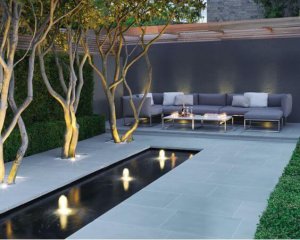Decorative Rills for Your Garden or Backyard

Rills (water channels) have had lots of different uses over the course of history. Some cultures used them in a purely functional way. But there were also others that gave them an aesthetic component, using them to beautify a space. With that in mind, we’re going to show you some decorative rills for your garden, and what to use them for.
Many civilizations used water channels as a way to transport water to places that didn’t generally get much water. For example, they might have used these channels to move water to vegetable plantations, irrigation lands, or just to bring water to people’s homes.
In the modern world, we’ve mostly put these kinds of channels and tubes under the streets and ground. But with that, we’ve lost the essence of what used to be a feat of engineering, bringing people their vital water, but also taking design inspiration from nature.
The importance of water in the Muslim world

Since the Middle Ages, Islamic culture has used all kinds of different types of techniques to transport water to agricultural areas. Its contributions were absolutely crucial in history, and have made their mark on modern designs.
They designed a perfect hydraulic system that would distribute water to places where people lived. They used cisterns, waterwheels, reservoirs, pools, or whatever else they needed to transport the water. However, water channels, or rills, were the most effective way.
But functionality wasn’t necessarily their only goal. They also used rills in a decorative way, and there’s no better example of that than the Alhambra in Granada. In other words, they used these rills and the water in them as a way to beautify their palaces.
Islamic culture put minute detail into all its designs as part of its fascination with beauty.
The decorative contributions of rills

So, if people have been using rills and water channels for decorative purposes for centuries, why shouldn’t you be able to do that nowadays in your garden? They look absolutely divine, so long as you have a clear sense of the aesthetic you’re going for before you start.
- The basic idea is that they’re small pools of water in a long, rectangular shape which helps them circulate. You’re not trying to make a swimming pool or a pond.
- Here’s are the general styles you’ll get out of a rill: historical, naturalistic, or avant-garde. Each of these three has very specific characteristics that will define your garden’s aesthetic.
- If you want, a rill doesn’t have to be functional, for things like watering a vegetable garden. Yours can be purely decorative, with a closed loop for the water, and some jets that keep the water from going stagnant.
- The important thing is for the water to have a presence of its own. To put it another way, your rills should create a naturalistic feel through the water’s circulation. It should make the area feel beautiful, and add a touch of necessary freshness.
Combining decorative rills with fountains

If you want to give your garden an especially original, eye-catching look, combining a rill with a fountain (or fountains) can be a great option. The fountain doesn’t necessarily have to become the main focus of the space, either. There’s definitely a way to combine them where they complement each other.
You could install a long, rectangular rill with small jets at the bottom, that push water to the top. It will create both a visual and auditory effect, giving your garden a practical and aesthetic touch with one simple feature.
Or, you could also install a small waterfall that feeds into another rill, or straight into a pool or pond. Doing that will make for an especially unique look in your outdoor space.
The main goal is for your garden to become a part of the house where water plays a major role.
Putting plants in the water

There’s no denying that rills can add a really nice decorative touch to a garden. But what if you took that even further and put plants in the water? That would make for an even more naturalistic look.
That doesn’t require you to make the rill into a still water pond, either. It just means putting in some aquatic plants that bob above the surface and add some green to the watery appearance.
This combination can make your garden look especially natural. It will create a perfect harmony between the water and the decorations in your home’s exterior. The best part of that is you’ll have a gorgeous, comfortable place to relax and entertain guests.
Rills (water channels) have had lots of different uses over the course of history. Some cultures used them in a purely functional way. But there were also others that gave them an aesthetic component, using them to beautify a space. With that in mind, we’re going to show you some decorative rills for your garden, and what to use them for.
Many civilizations used water channels as a way to transport water to places that didn’t generally get much water. For example, they might have used these channels to move water to vegetable plantations, irrigation lands, or just to bring water to people’s homes.
In the modern world, we’ve mostly put these kinds of channels and tubes under the streets and ground. But with that, we’ve lost the essence of what used to be a feat of engineering, bringing people their vital water, but also taking design inspiration from nature.
The importance of water in the Muslim world

Since the Middle Ages, Islamic culture has used all kinds of different types of techniques to transport water to agricultural areas. Its contributions were absolutely crucial in history, and have made their mark on modern designs.
They designed a perfect hydraulic system that would distribute water to places where people lived. They used cisterns, waterwheels, reservoirs, pools, or whatever else they needed to transport the water. However, water channels, or rills, were the most effective way.
But functionality wasn’t necessarily their only goal. They also used rills in a decorative way, and there’s no better example of that than the Alhambra in Granada. In other words, they used these rills and the water in them as a way to beautify their palaces.
Islamic culture put minute detail into all its designs as part of its fascination with beauty.
The decorative contributions of rills

So, if people have been using rills and water channels for decorative purposes for centuries, why shouldn’t you be able to do that nowadays in your garden? They look absolutely divine, so long as you have a clear sense of the aesthetic you’re going for before you start.
- The basic idea is that they’re small pools of water in a long, rectangular shape which helps them circulate. You’re not trying to make a swimming pool or a pond.
- Here’s are the general styles you’ll get out of a rill: historical, naturalistic, or avant-garde. Each of these three has very specific characteristics that will define your garden’s aesthetic.
- If you want, a rill doesn’t have to be functional, for things like watering a vegetable garden. Yours can be purely decorative, with a closed loop for the water, and some jets that keep the water from going stagnant.
- The important thing is for the water to have a presence of its own. To put it another way, your rills should create a naturalistic feel through the water’s circulation. It should make the area feel beautiful, and add a touch of necessary freshness.
Combining decorative rills with fountains

If you want to give your garden an especially original, eye-catching look, combining a rill with a fountain (or fountains) can be a great option. The fountain doesn’t necessarily have to become the main focus of the space, either. There’s definitely a way to combine them where they complement each other.
You could install a long, rectangular rill with small jets at the bottom, that push water to the top. It will create both a visual and auditory effect, giving your garden a practical and aesthetic touch with one simple feature.
Or, you could also install a small waterfall that feeds into another rill, or straight into a pool or pond. Doing that will make for an especially unique look in your outdoor space.
The main goal is for your garden to become a part of the house where water plays a major role.
Putting plants in the water

There’s no denying that rills can add a really nice decorative touch to a garden. But what if you took that even further and put plants in the water? That would make for an even more naturalistic look.
That doesn’t require you to make the rill into a still water pond, either. It just means putting in some aquatic plants that bob above the surface and add some green to the watery appearance.
This combination can make your garden look especially natural. It will create a perfect harmony between the water and the decorations in your home’s exterior. The best part of that is you’ll have a gorgeous, comfortable place to relax and entertain guests.
All cited sources were thoroughly reviewed by our team to ensure their quality, reliability, currency, and validity. The bibliography of this article was considered reliable and of academic or scientific accuracy.
- Stevens, David: Una habitación en exterior: diseñar el jardín en casa, Blume, 2008.







